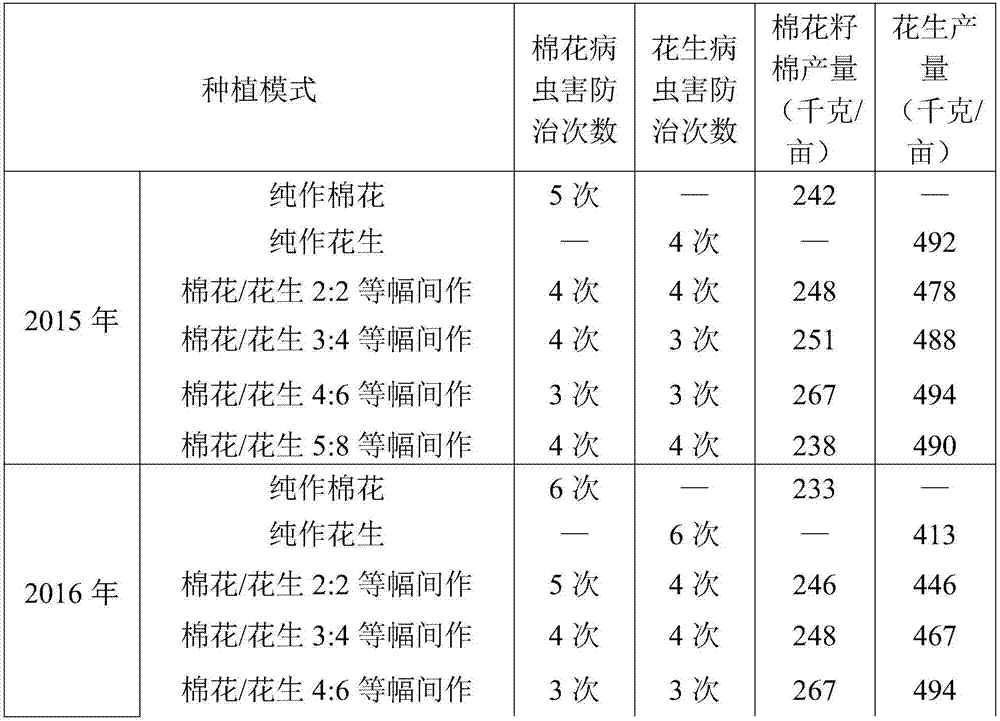Intercropping method of cotton and peanuts
A peanut and cotton technology, applied in the field of intercropping cotton and peanuts, can solve the problems of immature interplanting technology, excessive labor, rotten bells in rainy years, etc., and achieve the effect of overcoming continuous cropping obstacles and improving comprehensive economic benefits
- Summary
- Abstract
- Description
- Claims
- Application Information
AI Technical Summary
Problems solved by technology
Method used
Image
Examples
Embodiment 1
[0035] This experiment was carried out in Gaotang County, Liaocheng City in 2015 and 2016. The cotton and peanut intercropping rotation mode was adopted, and the intercropping method was 4 rows of cotton and 6 rows of peanuts. At the same time, pure cotton cropping, pure peanut cropping, 2 rows of cotton intercropping 2 rows of peanuts, 3 rows of cotton intercropping 4 rows of peanuts, and 5 rows of cotton intercropping 8 rows of peanuts were used as controls.
[0036]Peanut variety Huayu 36 and cotton variety K836 were used as test materials, and the land was cultivated in mid-March, and combined with the cultivated land, organic fertilizer and nitrogen, phosphorus and potassium compound fertilizer were applied as base fertilizers. In late March 2015, water was used to create moisture, and the soil was prepared before sowing, and 15 kg of pure nitrogen was applied per mu. Use mechanical ridges in the peanut pre-sowing row, the bottom width of the ridge is 76 cm, the back widt...
Embodiment 2
[0044] This experiment was carried out in Xiajin County, Dezhou City in 2015 and 2016. The intercropping mode of cotton and peanut was adopted, and the intercropping method was 4 rows of cotton intercropping and 6 rows of peanuts. At the same time, pure cotton cropping, pure peanut cropping, 2 rows of cotton intercropping 2 rows of peanuts, 3 rows of cotton intercropping 4 rows of peanuts, and 5 rows of cotton intercropping 8 rows of peanuts were used as controls.
[0045] Peanut variety Huayu 36 and cotton variety K836 were used as test materials, and the land was cultivated in mid-March, and combined with the cultivated land, organic fertilizer and nitrogen, phosphorus and potassium compound fertilizer were applied as base fertilizers. In late March 2015, water was used to create moisture, and the soil was prepared before sowing, and 15 kg of pure nitrogen was applied per mu. Use mechanical ridges in the peanut pre-sowing row, the ridge bottom is 70 cm wide, the ridge back i...
Embodiment 3
[0053] This experiment was carried out in Gaotang County, Liaocheng City in 2015 and 2016. The cotton and peanut intercropping rotation mode was adopted, and the intercropping method was 4 rows of cotton and 6 rows of peanuts. At the same time, pure cotton cropping, pure peanut cropping, 2 rows of cotton intercropping 2 rows of peanuts, 3 rows of cotton intercropping 4 rows of peanuts, and 5 rows of cotton intercropping 8 rows of peanuts were used as controls.
[0054] The peanut variety Huayu 22 and the cotton variety Lumianyan No. 28 were used as test materials, and the land was cultivated in mid-March, and organic fertilizer and nitrogen, phosphorus and potassium compound fertilizer were applied to the cultivated land as the base fertilizer. In late March 2015, water was used to create moisture, and the soil was prepared before sowing, and 15 kg of pure nitrogen was applied per mu. Use mechanical ridges in the peanut pre-sowing row, the bottom width of the ridge is 80 cm, t...
PUM
 Login to View More
Login to View More Abstract
Description
Claims
Application Information
 Login to View More
Login to View More - R&D
- Intellectual Property
- Life Sciences
- Materials
- Tech Scout
- Unparalleled Data Quality
- Higher Quality Content
- 60% Fewer Hallucinations
Browse by: Latest US Patents, China's latest patents, Technical Efficacy Thesaurus, Application Domain, Technology Topic, Popular Technical Reports.
© 2025 PatSnap. All rights reserved.Legal|Privacy policy|Modern Slavery Act Transparency Statement|Sitemap|About US| Contact US: help@patsnap.com



